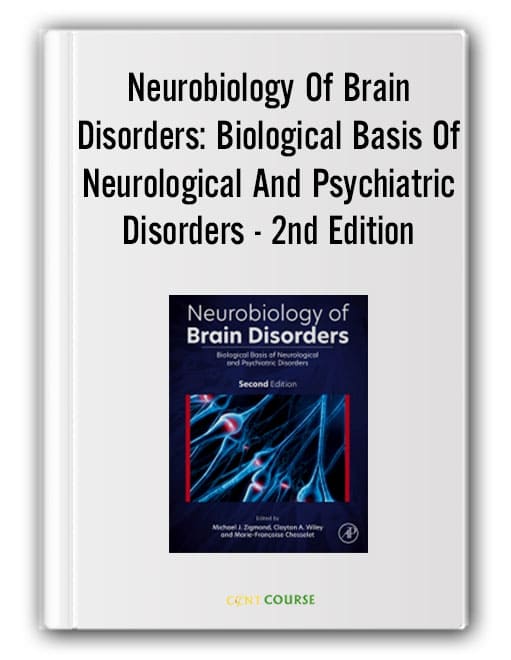Neurobiology of Brain Disorders: Biological Basis of Neurological and Psychiatric Disorders, 2nd Edition
This book covers the genetic, developmental, molecular, and cellular mechanisms underlying all significant categories of brain disorders.
Neurobiology of Brain Disorders Description
Basic scientists can get a thorough overview of neurological and neuropsychiatric illness from the second edition of Neurobiology of Brain Disorders: Biological Basis of Neurological and Psychiatric Disorders. This book covers the genetic, developmental, molecular, and cellular mechanisms underlying all significant categories of brain disorders, which combines fundamental, translational, and clinical research.
Here’s what you will learn in this course:
Section I. Introduction
- Chapter 1. Introduction
- Chapter 2. Developmental disabilities and metabolic disorders
- Chapter 3. Attention-deficit/hyperactivity disorder
- Chapter 4. Down syndrome: a model for chromosome abnormalities
- Chapter 5. Autism spectrum disorder
- Chapter 6. Rett syndrome: from the involved gene(s) to treatment
- Chapter 7. Fragile X-associated disorders
Section II. Diseases of the peripheral nervous system
- Chapter 8. Introduction
- Chapter 9. Myasthenia gravis
- Chapter 10. Muscular dystrophy
- Chapter 11. Peripheral neuropathies
- Chapter 12. Diabetes and cognitive dysfunction
- Conclusion
- Chapter 13. Tumors of the nervous system
Section III. Neurodegenerative diseases
- Chapter 14. Introduction to neurodegenerative disease section
- Chapter 15. Amyotrophic lateral sclerosis
- Chapter 16. Parkinson disease and other synucleinopathies
- Chapter 17. Huntington disease
- Chapter 18. Repeat expansion disorders
- Chapter 19. Alzheimer diseases
- Chapter 20. Frontotemporal lobar degeneration
- Chapter 21. Prion diseases
- Chapter 22. Toxic/metabolic diseases of the nervous system
- Chapter 23. The role of inflammation in neurodegenerative diseases
Section IV. Acute insults to the central nervous system
- Chapter 24. Introduction: acute insults to the central nervous system
- Chapter 25. Spinal cord injury
- Chapter 26. Traumatic brain injury
- Chapter 27. Cerebrovascular disease—stroke
Section V. Infectious and immune-mediated diseases affecting the nervous system
- Chapter 28. Introduction
- Chapter 29. Infections and nervous system dysfunctions
- Chapter 30. Pathobiology of CNS human immunodeficiency virus infection
- Chapter 31. Autoimmune and paraneoplastic neurological disorders
- Chapter 32. Fibromyalgia and myalgic encephalomyelitis/chronic fatigue syndrome
- Chapter 33. Multiple sclerosis and neuromyelitis optica spectrum disorders
Section VI. Diseases of higher function
- Chapter 34. Introduction
- Chapter 35. Disorders of higher cortical function
- Chapter 36. Neurobiology of sleep and circadian disorders
- Chapter 37. Restless Legs Syndrome
- Chapter 38. Pain: from neurobiology to disease
- Chapter 39. Migraine
- Chapter 40. Dystonia
- Chapter 41. Epilepsy
- Chapter 42. Stress
- Chapter 43. Addictions
- Chapter 44. Fear-related anxiety disorders and posttraumatic stress disorder
- Chapter 45. Obsessive–compulsive disorder
- Chapter 46. The neurobiology of schizophrenia
- Chapter 47. Depression and suicide
- Chapter 48. Inflammation as a mediator of stress-related psychiatric disorders
- Chapter 49. Role of the gut microbiome in the pathophysiology of brain disorders
Section VII. Interface between biology and society in diseases of the nervous system
- Chapter 50. Introduction
- Chapter 51. Sex differences in neurological and psychiatric diseases
- Chapter 52. Integrative medicine in neurology
- Chapter 53. The impact of isolation on brain health
- Chapter 54. The neurobiology of aging
- Chapter 55. Palliative care in neurological disease
- Chapter 56. Racial/ethnic health disparities
- Chapter 57. Advances in ethics for the neuroscience agenda
- Index
Related products
Free Download
Free Download
Free Download
Free Download
Free Download











